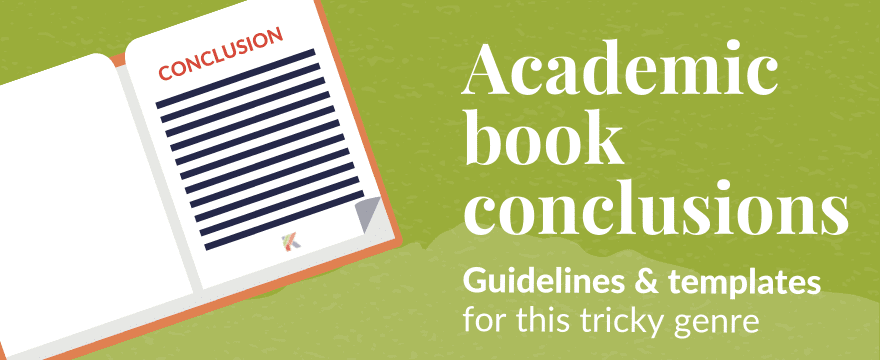Two main factors make writing an academic book’s conclusion tricky. First, there’s its content. You’ve presumably tied up all of the individual chapter threads in your body chapters’ conclusions. And you probably know that the conclusion should do something more than just restate the book’s main points. So, with (most) everything already said, what should your book conclusion even say?
Second, nothing follows the book’s conclusion. So, how should the book’s conclusion broaden the conversation if that conversation is about to (abruptly) end?
Whether you’ve been struggling to start your conclusion because you just don’t know what to say or you want to ensure your existing book conclusion draft conforms to academic book norms, this post has you covered with information and templates to try.
Let’s dive in.
How Long are Academic Book Conclusions?
According to Eric Hayot’s survey of 100 monographs, academic book conclusions usually account for 3.7% of the total words (The Elements of Academic Style 87). That means that a typical conclusion to an 80,000 word monograph would be just under 3,000 words.
Should My Academic Book Conclusion be Its Own Chapter? If So, What Should it be Called?
In the same survey, Hayot found that not all books have standalone conclusions. Surprisingly, in his sample, only 57% of books had standalone “conclusion” chapters, making them far from normative (87). Labeled “conclusion” sections can go by various names, like “coda” or “epilogue.” Many books in Hayot’s corpus folded the overall book concluding material into the final body chapter.
What If My Conclusion Feels Weak?
When my editor sent me the peer reviews of my book manuscript, he shared this tip: it’s common for authors–even very experienced senior scholars!–to be told that their conclusion needs to be completely redone. Conclusions are tricky, and a weaker conclusion likely won’t sink an otherwise strong book’s publication chances.
What Are Some Templates I Can Use to Plan My Academic Book Conclusion?
Knowing the information above helps you evaluate your book’s conclusion structurally and quantitatively. But it doesn’t help you know how, conceptually, to approach this section of your book. For that, use these templates for inspiration.
Academic Book Conclusion Template #1: Take a New Lens on the Familiar
We often want our writing to change how our reader “sees” things. Your conclusion can be the ideal place to show your reader exactly how much their perspective has shifted thanks to the claims you develop in the book.
Ask whether there is an example (perhaps from popular culture) with which your reader will likely be familiar that illustrates the themes you explore in your book. Then, close read it to show how what you’ve taught in the book gives them new insights into this familiar example.
Academic Book Conclusion Template #2: Offer Examples You Had to Cut
When revising your chapters, you likely had to cut some strong examples. Ask whether you could incorporate and analyze those examples in your book’s conclusion. Doing so can allow you to bring back many of the threads you developed in your book.
(Not sure what to cut and what to keep from your book? Check out The Dissertation-to-Book Workbook.)
Academic Book Conclusion Template #3: Bring the Material Up to the Present or Broaden the Scope
Often, conclusions broaden the book. If your book considers historical topics, ask whether your book’s conclusion could analyze more recent examples to show these topics’ legacies and continued relevance. Or, consider whether the conclusion could suggest broader applicability of your book’s ideas beyond its limited geographical or historical scope.
Academic Book Conclusion Template #4: Write Yourself In
This move is the riskiest of them all because it involves approaching your topic auto-ethnographically. If you have a personal connection to the material–say, you study the representation of a particular art form and you happen to practice that particular art form–your conclusion can be a place to reflect on that personal connection.



